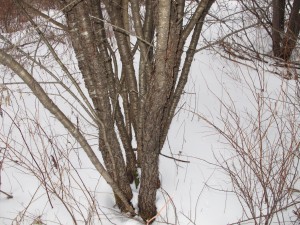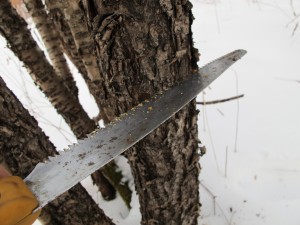Controlling Invasive Woody Plants
We’ve had a few days of spring-like weather and I’m champing at the bit, ready to start gardening as soon as the snow disappears. There’s not too much we can do as yet. One thing I’ve been doing recently is trying to get rid of invasive trees, specifically the common buckthorn. That’s a long process, so it’s a good thing to work on now, before planting season.
Common buckthorn and glossy buckthorn are two species of small trees that arrived here from Europe or Asia, where they are native, and that have found the new world (more than) suitable for their needs. They are understory plants that will grow in sun or shade, wet or dry, good soil or bad. And they are very hard to get rid of. Like many invasives, if you cut down one, many new shoots will sprout up.
I don’t use herbicides, but there is a way to kill buckthorns without using herbicides. Several years ago I was told about “double girdling” them as way to slowly kill them – without generating root sprouts. Now, while they are dormant, is a good time to begin.
Take a pruning saw and cut through the outer bark and the green cambium layer, but do not cut into the hard core of the trunk. Go all the way around the tree, so that you have girdled the tree. Be sure to connect the beginning and end of your cut (which requires that you keep your saw blade level as you cut). Then do it again 12 inches above the initial cut.
If you girdle the tree this year, it will leaf out and act as if nothing bad had occurred. Next year, it will leaf out, but may start to show signs of decline. In the third year, the tree will die. And best of all, no root sprouts will pop up. (Or they didn’t for me, anyhow, when I tried it a few years ago).
One problem: common buckthorn’s growth habit is to start off as a single trunk, and then immediately split off into 6-12 smaller trunks. Since I couldn’t double girdle the tree down low, I had to do so on each of the many upward-growing shoots. And another thing: buckthorns commonly have depressions or dimples in their stems. So when cutting through the bark, it is easy to miss a section because your saw can go over a dimple and leave the job incomplete.
Norway maples (Acer platanoides) are on the list of invasive species in most New England states, and also need to be weeded out. They are on the list because they can out-compete our native maples (and other trees) for water, sunlight and nutrients, and because they seed into the woods whenever present. I have not tried the double girdling technique on them because I have none on my property. But if you have some, I suggest you try it – and then please email me in 3 years if the technique works.
‘Crimson King’ is a cultivar of Norway maple that is very attractive, with nice dark purple leaves. It was sold in huge numbers up until recently. It is a hybrid, and the numerous seedlings it produces are mostly green-leaved – which means that most gardeners just assume that the maple seedlings they see in their woods are native maples. There is a way to test a maple to see if it is a Norway. Once summer comes, snap off a leaf and look at the base of the petiole (leaf stem). If it oozes white sap, it’s a Norway maple.
Other trees and shrubs that can be invasive include bush honeysuckle, tree of heaven, barberry , Russian olive, autumn olive, burning bush, border privet, princess tree (Powlownia tomentosa), and multiflora rose. Most share these characteristics: they are tough trees, produce lots of seeds, and will out-compete native species – they have been introduced from abroad.
I recently spoke to Blaine Moore of Maverick Farm in Sharon, VT about a technique he has used on invasives. He cuts them off close to ground level, and then covers the cut stem with a tin can so that no light gets to the stem – light can stimulate cut stems to grow or to send up root sprouts. He told me he has used this technique successfully for a number of years on a variety of types of invasives and he swears by it. I have not tried this yet, but I have lots of honeysuckle, and I will try it this spring – it’s much less work than digging them out. He sometimes uses tuna cans and nails the can onto a stump to keep it in place.
I have written in the past about a nifty tool for pulling young woody invasives, the weed wrench (www.weedwrench.com). This is a very sturdy hand tool that allows you to grab onto a tree or shrub with a self-tightening jaw, and pull them out with the leverage of a steel arm. They come in four sizes and are a good investment for garden clubs. Of course you will have to wait until the soil thaws to start pulling out culprits. Meanwhile, go try some double-girdling.
Henry Homeyer can be reached by email at henry.homeyer@comcast.net. His Web site is www.Gardening-Guy.com.




